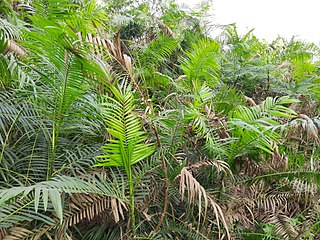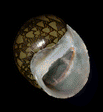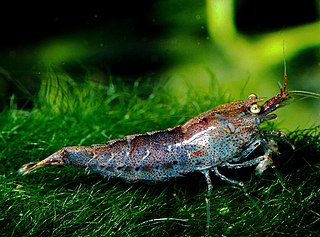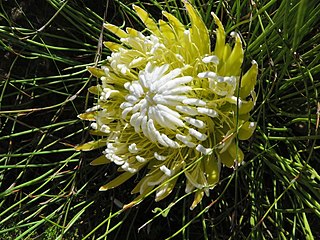
Acorus calamus is a species of flowering plant with psychoactive chemicals. It is a tall wetland monocot of the family Acoraceae, in the genus Acorus. Although used in traditional medicine over centuries to treat digestive disorders and pain, there is no clinical evidence for its safety or efficacy – and ingested calamus may be toxic – leading to its commercial ban in the United States.

The conservation status of a group of organisms indicates whether the group still exists and how likely the group is to become extinct in the near future. Many factors are taken into account when assessing conservation status: not simply the number of individuals remaining, but the overall increase or decrease in the population over time, breeding success rates, and known threats. Various systems of conservation status exist and are in use at international, multi-country, national and local levels as well as for consumer use.

Platanthera praeclara, known as the western prairie fringed orchid and the Great Plains white fringed orchid, is a rare and threatened species of orchid native to North America.

The Threatened Species Protection Act 1995, is an act of the Parliament of Tasmania that provides the statute relating to conservation of flora and fauna. Its long title is An Act to provide for the protection and management of threatened native flora and fauna and to enable and promote the conservation of native flora and fauna. It received the royal assent on 14 November 1995.

Cephalotaxus oliveri is a coniferous shrub or small tree in the family Taxaceae. It is native to China and possibly to Thailand, Laos, Vietnam and eastern India.

The richness and variety of the wildlife of Ethiopia is dictated by the great diversity of terrain with wide variations in climate, soils, natural vegetation and settlement patterns. Ethiopia contains a vast highland complex of mountains and dissected plateaus divided by the Great Rift Valley, which runs generally southwest to northeast and is surrounded by lowlands, steppes, or semi-desert.
Calamus compsostachys is a species of flowering plant in the family Arecaceae. It is found only in China. Its natural habitats are subtropical or tropical dry forests and subtropical or tropical moist lowland forests.
Calamus egregius is a species of flowering plant in the family Arecaceae. It is found only in the Hainan region of China. Its natural habitats are subtropical or tropical moist lowland forests and subtropical or tropical moist montane forests.
Calamus inermis is a species of flowering plant in the family Arecaceae. It is found native to the Yunnan region of China and Indochina. Its natural habitat is subtropical or tropical seasonal forests. It is threatened by habitat loss.
Aristolochia utriformis is a species of plant in the family Aristolochiaceae. It is endemic to China. It is found in forests at about 1900 meters in Yunnan Province. The plants are climbing herbs or shrubs that have pointed leaves with heart shaped bases. The yellow-green flowers are tube shaped and bent. They hang from the base of a leaf.

Helicia is a genus of 110 species of trees and shrubs, constituting part of the plant family Proteaceae. They grow naturally in rainforests throughout tropical South and Southeast Asia, including India, Sri Lanka, Indochina, Peninsular Malaysia to New Guinea and as far south as New South Wales.

Quercus dumosa is a species of plant in the family Fagaceae, belonging to the white oak section of the oak genus (Quercus). This tree goes by the common names coastal sage scrub oak and Nuttall's scrub oak.

The flora of China consists of a diverse range of plant species including over 39,000 vascular plants, 27,000 species of fungi and 3000 species of bryophytes. More than 30,000 plant species are native to China, representing nearly one-eighth of the world's total plant species, including thousands found nowhere else on Earth. China's land, extending over 9.6 million km, contains a variety of ecosystems and climates for plants to grow in. Some of the main climates include shores, tropical and subtropical forests, deserts, elevated plateaus and mountains. The events of the continental drift and early Paleozoic Caledonian movement also play a part in creating climatic and geographical diversity resulting in high levels of endemic vascular flora. These landscapes provide different ecosystems and climates for plants to grow in, creating a wide variety of different flora spanning over not just China but different parts of the world now.

Calamus tenuis is a species of flowering plant in the family Arecaceae. It is native to India, Assam, Bangladesh, Bhutan, Cambodia, Laos, Burma, Thailand, Vietnam, Java and Sumatra.

Celtis philippensis, is an Asian species of flowering plant in the family Cannabaceae.

Clithon oualaniense is a species of brackish water snail with an operculum, a nerite. It is an aquatic gastropod mollusk in the family Neritidae, the nerites.

Neocaridina palmata is a freshwater shrimp found in China and Vietnam. It is found in rivers, streams and ponds. Their preferred habitat is heavily planted, slow flowing water.
Protea asymmetrica, also known as the Inyanga sugarbush, is a flowering plant, named for its asymmetric flowerheads, of the family Proteaceae and endemic to Zimbabwe and the Nyanga region, where it grows in grasslands, as well as Mount Nyangani.

Protea lorea, also known as the thong-leaf sugarbush, is a flowering shrub belonging to the genus Protea.
Neocaridina bamana is a freshwater shrimp found in the Guangxi region of China. Besides that the species lives in freshwater, little is known about its habitat due to a lack of data about the collection site.














